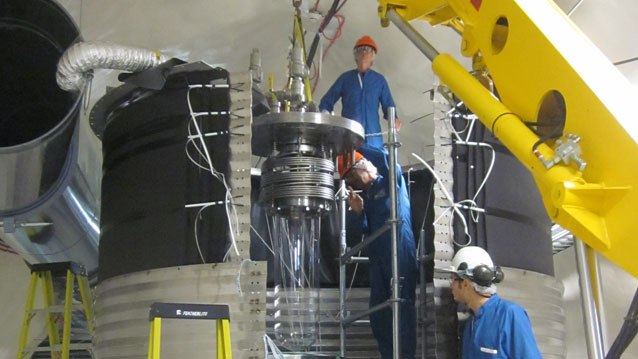EVANSTON, Ill. --- Northwestern University physicist Eric Dahl is part of a group of physicists that has just launched an unusual new experiment in an attempt to be the first to directly confirm the existence of dark matter.
Scientists this week heard their first pops in an experiment that searches for signs of dark matter in the form of tiny bubbles. The experiment’s one-of-a-kind detector is located in a laboratory a mile and a half underground in Sudbury, Ontario.
The physicists will need to analyze the data to discern whether dark matter caused any of the COUPP-60 experiment’s first bubbles. COUPP stands for the Chicagoland Observatory for Underground Particle Physics.
The experiment, which includes 23 physicists, is being led by the University of Chicago, Northwestern and the U.S. Department of Energy’s Fermi National Accelerator Laboratory. Fermilab managed the assembly and installation of the dark-matter detector.
“For every gram of light matter, or atoms, in the universe, there are 5.5 grams of dark matter,” said Dahl, an assistant professor of physics and astronomy in the Weinberg College of Arts and Sciences. “It is still unknown what this dark matter is actually made of, but whatever it is, it’s something new. Physicists already have ruled out every known particle.
“If we do find dark matter, not only will we answer one of the biggest mysteries in cosmology and astrophysics, we’ll be seeing into a new world of particle physics as well,” he said. “The potential payoff is huge.”
Gravitational evidence for the existence of dark matter abounds. As early as 1933 astrophysicists found that the observed motions of galaxies require much more gravitational matter than can be accounted for by the matter we can see (in the form of stars and gas). Since then, a series of astrophysical and cosmological measurements, from observations of light bending around distant galaxy clusters to studies of the microwave background radiation left over from the big bang, all confirm that most of the matter in the universe is dark.
Fortunately there is lots of dark matter on hand to study, Dahl said. In a volume the size of your fist there is on average one dark matter particle, typical flying by at a few hundred kilometers-per-second. Most of these particles do absolutely nothing, but many dark matter theories predict that, very rarely, these particles will collide with the nucleus of an atom. Just like two balls on a pool table, that nucleus will carry away some kinetic energy -- in this case an energy equivalent to a single X-ray photon.
Picking out this weakly recoiling nucleus is the task of Dahl and the other members of COUPP. The COUPP collaborators build bubble chambers -- large volumes of liquid heated to temperatures slightly above their boiling point. Like a mug of water heated in a microwave, however, the super-heated liquid will not boil without a nucleation site. In this case, that nucleation site is created by the dark-matter interaction. One dark-matter particle hitting one nucleus creates a single bubble in the chamber.
To date, no experiment has actually seen a dark-matter interaction, but that could change with the latest COUPP chamber.
Containing a dark-matter target of 30-liters (60 kg) of superheated trifluoroiodomethane (CF3I), the COUPP-60 experiment was turned on May 1 in a laboratory 6,800 feet underground at SNOLAB in Sudbury, Ontario. The underground location is necessary to eliminate particle backgrounds from cosmic rays that might create bubbles in the chamber. Acoustic sensors sensitive to the ultrasonic “plink” from a forming bubble also let the COUPP scientists distinguish between dark-matter events and less interesting particle backgrounds.
While waiting for the rare bubble from a dark-matter interaction, Dahl and the rest of COUPP are already at work building their next bubble chamber, which will weigh half a ton and also be located at SNOLAB.
The COUPP collaborators are not alone in their quest -- there is plenty of competition from a variety of scientists and technologies to be the first to observe a dark-matter particle. In fact, COUPP is a relative newcomer to the field, but the low cost and fast deployment of the COUPP technology has quickly made it a front-runner in the hunt for dark matter.


